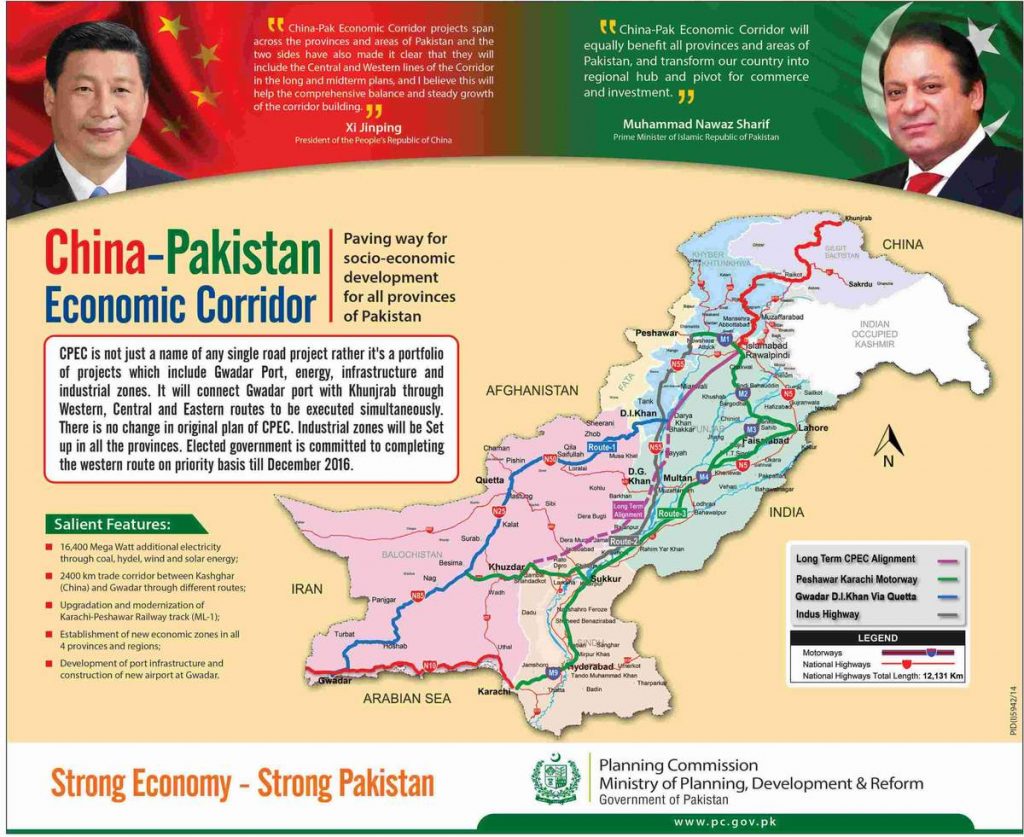
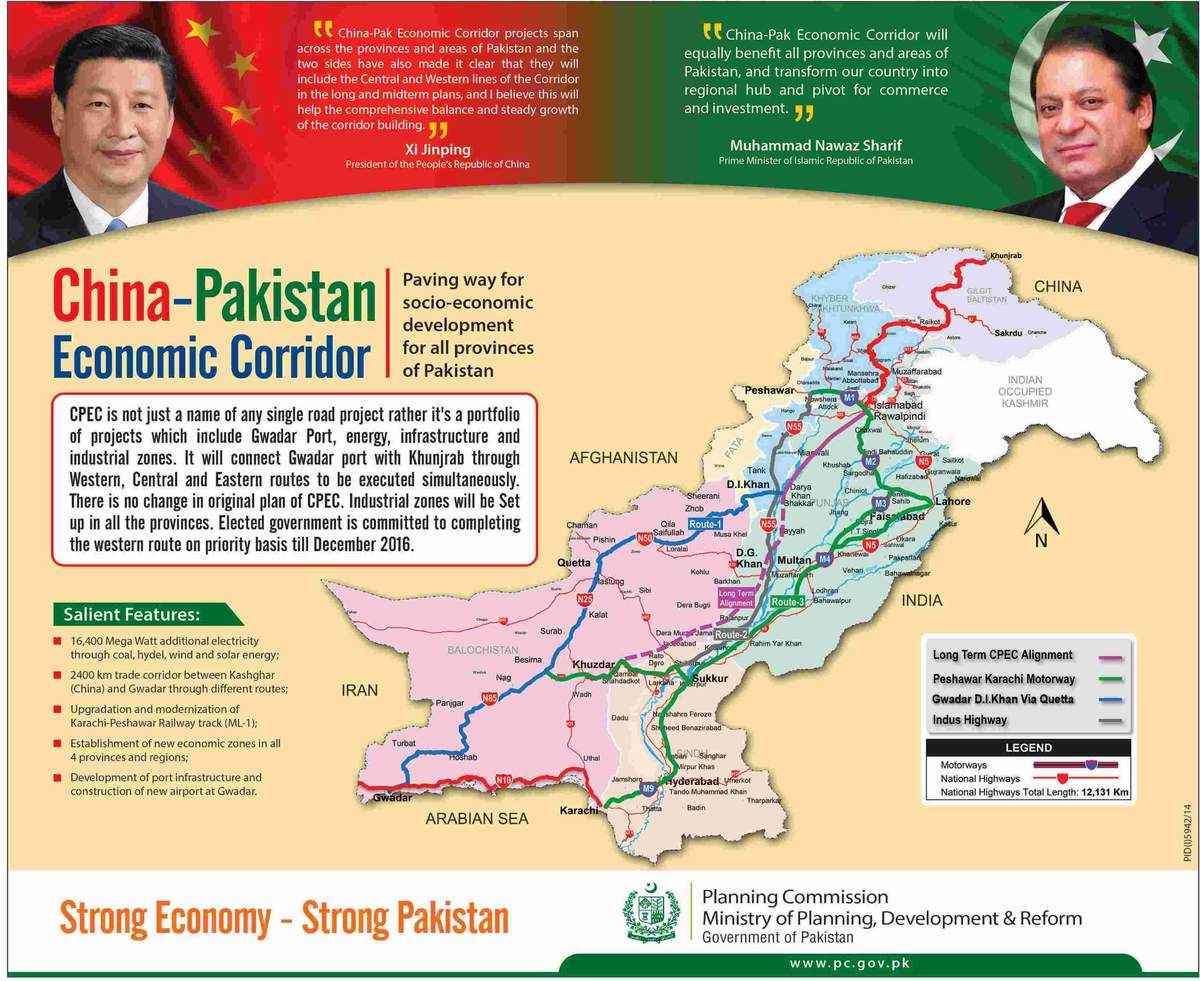
The China–Pakistan Economic Corridor often referred to by the acronym CPEC, is a collection of projects currently under construction at a cost of $51 billion, intended to rapidly expand and upgrade Pakistani infrastructure as well as deepen and broaden economic links between Pakistan and the People’s Republic of China.
The corridor is considered to be an extension of China’s ambitious One Belt, One Road initiative, and the importance of CPEC to China is reflected by its inclusion as part of China’s 13th five-year development plan.
Pakistani officials predict that the project will result in the creation of upwards of 700,000 direct jobs between 2015–2030, and add 2 to 2.5 percentage points to the country’s annual economic growth. Were all the planned projects to be implemented, the value of those projects would be equal to all foreign direct investment in Pakistan since 1970, and would be equivalent to 17% of Pakistan’s 2015 gross domestic product.
Plans for a corridor stretching from the Chinese border to Pakistan’s deep water ports on the Arabian Sea date back to the 1950s, and motivated construction of the Karakoram Highway beginning in 1959.
Chinese interest in Pakistan’s deep-water harbour at Gwadar had been rekindled by 1998 and in 2002 China began construction at Gwadar port which was completed in 2006.
China’s ambition and Pakistan industrial growth is highly dependent on this corrider.
Juma Khan, a resident of Gwadar, is happy to see massive business activity at his coastal hometown. Coming from a very humble economic background, the young man had adopted fishing to feed his family. Life has been hard and bitter in his area, at least till a few years ago.
Then work on Gwadar Port began and so he also found an honourable job. Once developed, the port is set to act as a linchpin for One Belt One Road initiative launched by China’s visionary President Xi Jinping to link Asia to rest of the world through the shortest possible trade route.
The port is capable of becoming a hub of trans-regional trade from Asia Pacific and central Asian states and to ship goods to Europe, Africa, America and the Middle East.
Juma Khan hopes that sooner rather than later his city would become a hub of economic activity and most modern civic facilities would be at his doorstep. He is right to hold such high hopes because of the massive development.
However, the poor soul does not know his dreams may be jeopardised as a few influential people do not like the rapid development taking place in Gwadar. Powerful mafias are working to throw a spanner in the development works out of fear of losing free and cheap labour and blind voters who have been kept below the poverty line – thanks to constant and unending poverty, slavery and hunger in and around Gwadar.
Gwadar is a district located on the mouth of the Arabian Sea, about 700 kilometres from Karachi and 120 km from the Iranian border. With an area of 12,637 kilometres, the port city is strategically located near Persian Gulf countries, Eastern European countries Armenia, Georgia, Azerbaijan and Western Asian countries Iran and Turkey.
Gwadar used to be a small, sleepy city until 2002 when then General Musharraf’s regime came up with a turnaround plan. Until 1958, Gwadar was an overseas possession of Oman. On September 8, 1958 it was annexed by Pakistan after Oman sold its enclave to Pakistan for a price of Rs5.5 billion, with effect from December 8, 1958.
The area was not integrated into Balochistan July 1, 1977, when it became a full sub-division called Gwadar District and was designated as the “winter capital” of Balochistan.
Most of the money for buying the land from Oman came from donations, with Prince Sultan Mohammad Shah, the reigning Aga Khan, being the greatest contributor, while the remainder was raised through taxes.
In 1993, Benazir Bhutto’s government conceived the plan to develop Gwadar into a major port city with a deep-sea port and to connect it with Pakistan’s highway and rail networks. However, it was General Musharraf who launched practical development work on the port. On 22 March 2002, Pakistan began phased construction of Gwadar Port.
The Port was inaugurated on 20 March 2007 – a step which irked tribal chieftains who warned the army leader and then started an insurgency.
Perhaps tribal chiefs, mostly graduated from western universities, wanted to keep their people uneducated so they could remain leaders and keep the tribes loyal to them.
Interestingly, Gwadar is the area of Balochistan where neither nationalist parties nor tribal chieftains had any interest until 2002 when developing of the port started.
With the launching of China-Pakistan Economic Corridor (CPEC), Gwadar has seen fast paced development. A Free Trade Zone is being constructed on 2,282 acres of land. The land agreement has been signed while the approval for Rs6.499 billion had been given for acquisition of 1,628 acres of land from private owners.
The China Overseas Ports Holding Company and its subsidiary Gwadar Free Zone Company are finalising the documents of the Initial Project of the FZ, as well as the Master Plan of the entire Free Zone. Recently, the handing and taking over of the land for initial project and Phase-1 was also completed on November 11, 2015 at Quetta by Chief Minister Dr Abdul Malik.
Gwadar Free Zone Plan (phase-I) is a project to be completed from 2015-2020. Its basic objective is to develop a commercial logistics centre, exhibition hall and some industries with local resources including fisheries, livestock, etc. This project is very important to cultivate an investment and business environment in the area.
Phase-II of the project would be completed by 2025. Under the blueprint, processing and manufacturing industries will be developed in Gwadar by 2025. And the influence of the industrial park will be formed gradually.
Phase-III would be completed by 2030. This would be the maturity period. Enlargement the scale of the Free Zone will be an important part of the China-Pakistan Economic Corridor commercial and industrialisation initiatives, and an engine of local economic and industrial development. The spatial layout is planned into commercial logistics areas in the south and manufacturing areas in the north.
Top ministerial level delegates from Pakistan and China have recently met in Karachi to review the progress of these projects. The meeting, called the Joint Cooperation Committee (JCC), expressed its satisfaction on progress achieved so far.
On the occasion, the handing-taking over of a large part of the Gwadar Port Free Zone was also held in Quetta. Both sides agreed that the remaining land might also be handed over to the Free Zone operating Chinese company by addressing the outstanding issues related to vacation of small portion of land and issuance of the SROs related to the Gwadar Port and Free Zone by Pakistan.
The JCC also appreciated the progress on social sector projects such as new schools, a 300-bed hospital and scholarships. The JCC was briefed about the various Gwadar related projects. Both sides agreed that the meeting of the Gwadar Joint Working Group (JWG) would be held at an early date so that projects and other cooperation initiatives are expedited in a systematic way.
It was also decided to speed up work on two small infrastructure projects, that is, the Eastbay Expressway and New Gwadar International Airport. It was also agreed in principle that Pakistan would continue with the ongoing bidding process for the Eastbay Expressway.
Both sides agreed that the water and energy related projects should be given top priority, and should be processed in a speedy manner by the respective working groups.
Both sides also agreed to sign an agreement for development of the Gwadar smart port city master plan at the earliest.
Pakistan suggested that the projects of Solid Waste Management System including Recycling Plant for Gwadar City, Intercept Drain for Flood Protection and Storm Water Drainage System for Gwadar City and Digitisation of Land Record of GDA Master Plan should be included in the China-Pakistan Economic Corridor (CPEC).
But this pace of development work is worrying many. One of the major critics of Gwadar development is former Balochistan Chief Minister Akhtar Jan Mengal, the chief of his own faction of Balochistan National Party (BNP-Mengal) whose own government did nothing for development in Gwadar.
When contacted for comments, the BNP-Mengal Secretary-General Senator Jehanzeb Jamaldini had nothing concrete to oppose the development plan of Gwadar. Jamaldini looks ignorant even of the actual development plan at Gwadar.
It is interesting to note that the ruling party, National Party (NP) and BNP-M, both have political support in and around Gwadar. However, it seems that the people of Gwadar rejected the BNP-M the very next year during the local government elections and voted for Dr Abdul Malik’s National Party (NP) with the exceptional development in the area.
Senator Jamaldini says that his party, BNP-M, had won in 2013 polls from Gwadar and most of their lawmakers were from Gwadar.
He said since Gwadar is central point for CPEC, the local lawmakers should be involved in designing of the projects so they could better advise the development of the port and free trade zone.
“We want to make it clear to the government that a demographic change would be unacceptable in garb of development. Gwadar is ours and local population must be given priority in development,” he said.
Jamaldini added that his party would need guarantees that demography of Gwadar would not be changed and right to vote would not be given to those arriving in Gwadar for development work.
“Since Gwadar would be the hub for all projects and a lot of projects would be undertaken, skill building institutions should be established in the area so locals are given preference and they are empowered,” he elaborated.
However, what Jamaldini does not know is that work for Technical and Vocational Institute at Gwadar is already underway and skill building of locals is a part of the master plan. The institute is named Pak-China Technical and Vocational Institute at Gwadar.
The objective of the institute is to impart skill training to the people of Gwadar who are the main and fundamental stakeholders of the port city. Their participation in operation and management of the deep-sea port, industrial and commercial businesses, and urbanisation processes is a key to the all long-term developmental initiatives. This project has been proposed to shape and enhance skills of active population of Gwadar to participate in growth of the Port city.
Projects in Gwadar Port and City
Gwadar forms the crux of the CPEC project, as it is envisaged to be the link between China’s ambitious One Belt, One Road project, and its Maritime Silk Road project.
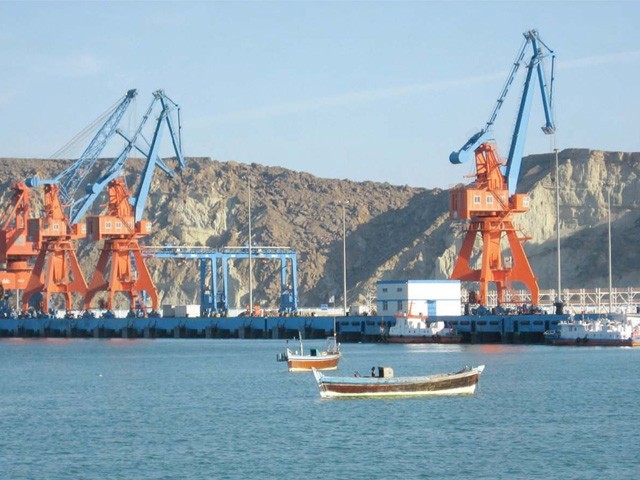
In total, more than $1 billion worth of projects are to be developed around the port of Gwadar by December 2017.
Initial infrastructure works at Gwadar Port commenced in 2002 and were completed in 2007. Under CPEC agreement, Gwadar Port will initially be expanded and upgraded to allow for docking of larger ships with deadweight tonnage of up to 70,000. The expanded port will be located near a 2,282 acre free trade area in Gwadar which is being modeled on the lines of the Special Economic Zones of China.
The site will include manufacturing zones, logistics hubs, warehouses, and display centres. Businesses located in the zone would be exempt from customs authorities as well as many provincial and federal taxes. Businesses located in the zone would be exempt from customs authorities as well as many provincial and federal taxes.Contractors and subcontractors associated with China Overseas Port Holding Company will be exempted from such taxes for 20 years, while a 40-year tax holiday will be granted for imports of equipment, materials, plant/machinery, appliances and accessories that are to be for construction of Gwadar Port and special economic zone.
The special economic zone will be completed in three phases. By 2025, it is envisaged that manufacturing and processing industries will be developed, while further expansion of the zone is intended to be complete by 2030.
China will grant Pakistan $230 million to construct a new international airport in Gwadar which is to be operational by December 2017. The provincial government of Balochistan has set aside 4000 acres for the construction of the new $230 million Gwadar International Airport which will require an estimated 30 months for construction,the costs of which are to be fully funded by grants from the Chinese government which Pakistan will not be obliged to repay.
The city of Gwadar is further being developed by the construction of a 300MW coal power plant, a desalinisation plant, and a new 300 bed hospital. Plans for Gwadar city also include construction of the East Bay Expressway – a 19 kilometre controlled-access road that will connect Gwadar Port to the Makran Coastal Highway. These additional projects are estimated to cost $800 million, and are to be financed by 0% interest loans extended by the Exim Bank of China to Pakistan.
Roadway projects
The CPEC project envisages major upgrades and overhauls to Pakistan’s transportation infrastructure. Under the CPEC project, China has announced financing for $10.63 billion worth of transportation infrastructure so far; $6.1 billion have been allocated for construction “Early Harvest” roadway projects at an interest rate of 1.6 percent. The remainder of funds will be allocated when the Pakistani government awards contracts for construction of road segments which are still in the planning phase.
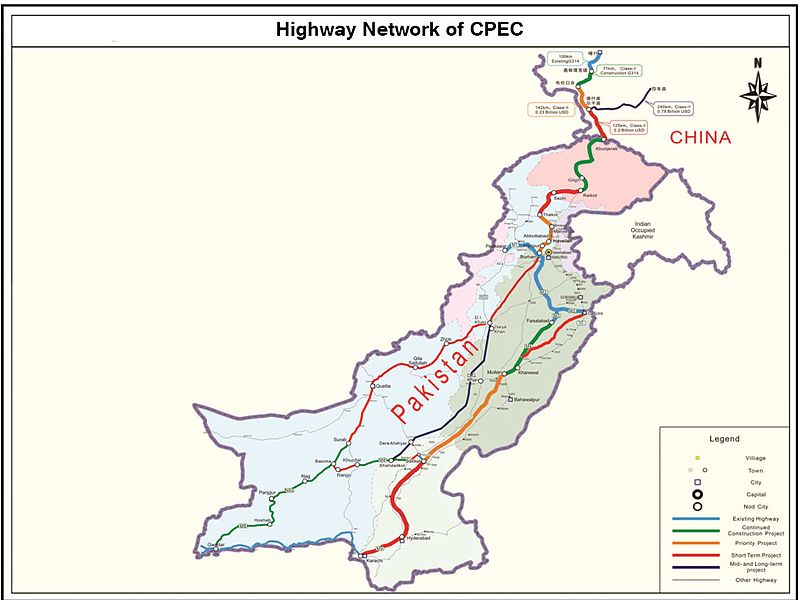
Three corridors have been identified for cargo transport: the Eastern Alignment though the heavily populated provinces of Sindh and Punjab where most industries are located, the Western Alignment through the less developed and more sparsely populated provinces of Khyber Pakhtunkhwa and Balochistan, and the future Central Alignment which will pass through Khyber Pakhtunkhwa, Punjab, and Balochistan.
Karakoram Highway reconstruction
The CPEC projects call for reconstruction and upgrade works on National Highway 35 (N-35), which forms the Pakistani portion of the Karakoram Highway. The KKH spans the 887 kilometre long distance between the China-Pakistan border and the town of Burhan, near Hasan Abdal. At Burhan, the existing M1 motorway will intersect the N-35 at the Shah Maqsood Interchange. From there, access onwards to Islamabad and Lahore continues as part of the existing M1 and M2 motorways. Burhan will also be at intersection of the Eastern Alignment, and Western Alignment.
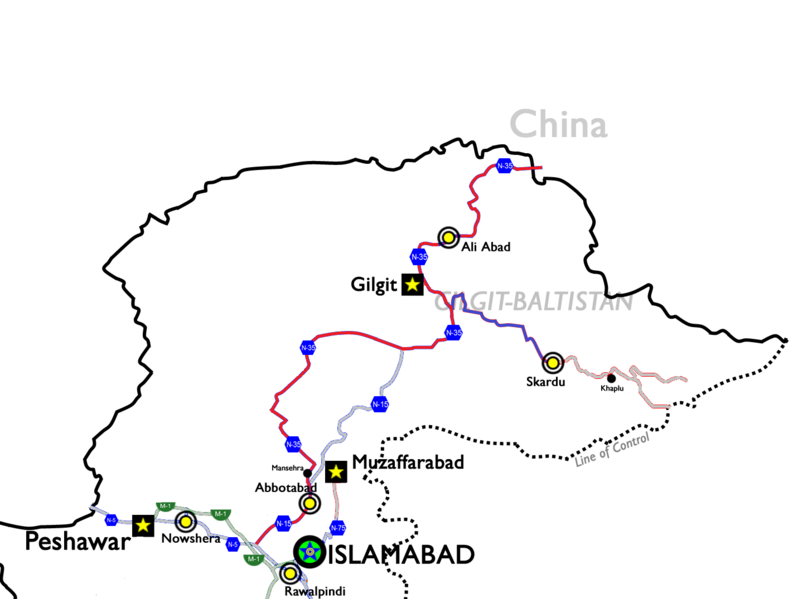
Upgrades to the 487 kilometer long section between Burhan and Raikot of the Karakoram Highway are officially referred to in Pakistan as the Karakoram Highway Phase 2 project. At the southern end of the N-35, works are already underway to construct a 59-kilometer-long, 4-lane controlled-access highway between Burhan and Havelian which upon completion will be officially referred to as the E-35 expressway.
Eastern Alignment
The term Eastern Alignment of CPEC refers to roadway projects located in Sindh and Punjab provinces – some of which were first envisioned in 1991. As part of the Eastern Alignment, a 1,152 km long motorway will connect Pakistan’s two largest cities, Karachi and Lahore with 4 to 6-lane controlled access highway designed for travel speeds up to 120 kilometres per hour. The entire project will cost approximately $6.6 billion, with the bulk of financing to be distributed by various Chinese state-owned banks.
The entire Eastern Alignment motorway project is divided into four sections: a 136 kilometre long section between Karachi and Hyderabad also known as the M9 motorway, a 296 kilometre long section between Hyderabad and Sukkur, a 387 kilometre long section between Sukkur and Multan, and a 333 kilometre section between Multan and Lahore via the town of Abdul Hakeem.
Western Alignment
The CPEC project envisages an expanded and upgraded road network in the Pakistani provinces of Balochistan, Khyber Pakhtunkhwa, and western Punjab Province as part of the Western Alignment. The Western Alignment project will result in the upgrading of several hundred kilometre’s worth of road into 2 and 4-lane divided highways by mid-2018, with land acquisition sufficient for upgrading parts of the road to a 6-lane motorway in the future. In total, the CPEC project envisages re-construction of 870 kilometres of road in Balochistan province alone as part of the Western Alignment.
The Western Alignment roadway network will begin at the Barahma Bahtar Interchange on the M1 Motorway near the towns of Burhan and Hasan Abdal in northern Punjab province. The newly reconstructed Karakoram Highway will connect to the Western Alignment at Burhan, near where the new 285 kilometre long controlled-access Brahma Bahtar-Yarik Motorway will commence. The motorway will terminate near the town of Yarik, just north of Dera Ismail Khan. The motorway will traverse the Sindh Sagar Doab region, and cross the Indus River at Mianwali before entering into Khyber Pakhtunkhwa province. It will consist of 11 interchanges, 74 culverts, and 3 major bridges spanning the Indus,Soan, and Kurram Rivers. Total costs for the project are expected to be $1.05 billion.
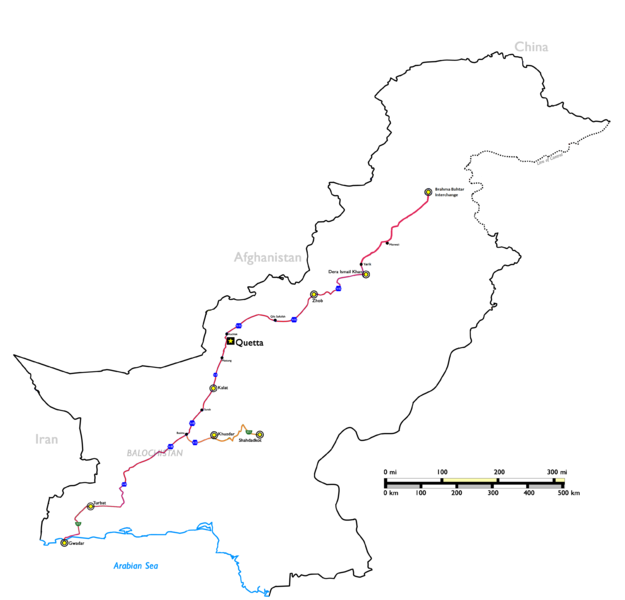
Along the Western Alignment route, the towns of Hoshab and Gwadar are connected by a newly-built 193 kilometre long portion of the M8 Motorway – the Hoshab to Gwadar portion of the motorway was completed and inaugurated in February 2016 by Prime Minister Nawaz Sharif.
Long-term plans for a “Central Alignment” of the CPEC consist of a network of roads which will commence in Gwadar and travel upcountry via the cities of Basima, Khuzdar, Sukkur, Rajanpur, Layyah, Muzaffargarh, and terminating in Dera Ismail Khan, with onward connections to Karakoram Highway via the Brahma Bahtar–Yarik Motorway.
Railway projects
The CPEC project emphasises major upgrades to Pakistan’s ageing railway system, including rebuilding of the entire Main Line 1 railway between Karachi and Peshawar by 2020; this single railway currently handles 70% of Pakistan Railways traffic. In addition to the Main Line 1 railway, upgrades and expansions are slated for the Main Line 2 railway, Main Line 3 railway. The CPEC plan also calls for completion of a rail link over the 4,693-meter high Khunjerab Pass. The railway will provide direct access for Chinese and East Asian goods to Pakistani seaports at Karachi and Gwadar by 2030.
Procurement of an initial 250 new passenger coaches, and reconstruction of 21 train stations are also planned as part of the first phase of the project – bringing the total investment in Pakistan’s railway system to approximately $5 billion by the end of 2019. 180 of the coaches are to be built at the Pakistan Railways Carriage Factory near Islamabad, while the Government of Pakistan intends to procure an additional 800 coaches at a later date, with the intention of building 595 of those coaches in Pakistan.
Overhaul of Main Line 1 Railway
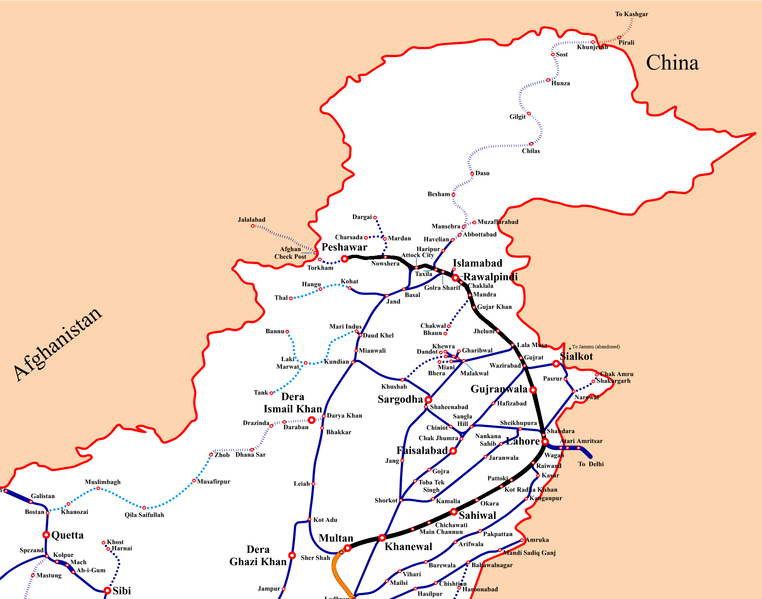
The CPEC “Early Harvest” plan includes a complete overhaul of the 1,687 kilometre long Main Line 1 railway (ML-1) between Karachi and Peshawar at a cost of $3.65 billion for the first phase of the project, with the first phase expected to be completed by December 2017. In June 2016, China and Pakistan unveiled plans for the second phase of the project, with a total cost of $8.2 billion for both phases of the project. The second phase of the ML-1 overhaul project is expected to be completed in 2021.
Overhaul of Main Line 2 Railway
In addition to upgrading the ML-1, the CPEC project also calls for similar major upgrade on the 1,254 kilometre long Main Line 2 (ML-2) railway between Kotri in Sindh province, and Attock in northern Punjab province via the cities of Larkana and Dera Ghazi Khan.
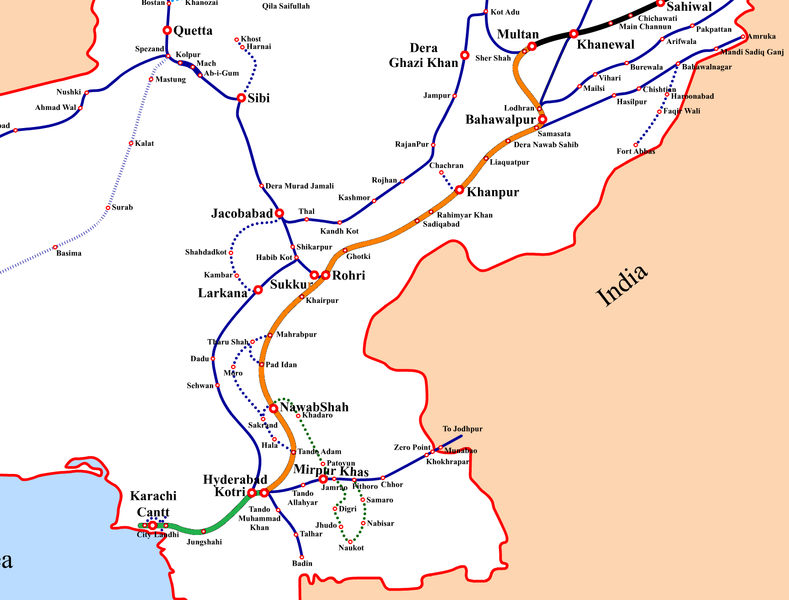
The route towards northern Pakistan roughly parallels the Indus River, as opposed to the ML-1 which takes a more eastward course towards Lahore. The project also includes a plan to connect Gwadar, to the town of Jacobabad, Sindh which lies at the intersection of the ML-2 and ML-3 railways.
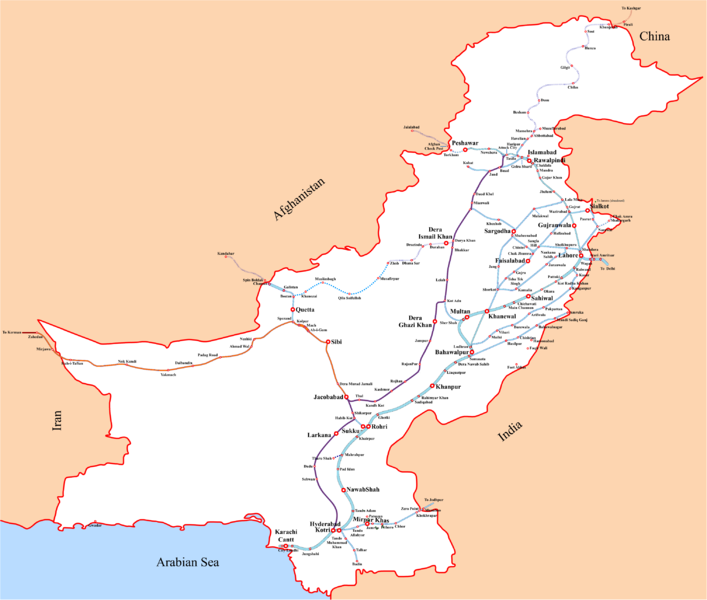
Overhaul of Main Line 3 Railway
Medium term plans for the Main Line 3 (ML-3) railway line will also include construction of a 560 kilometre long railway line between Bostan near the Afghanistan border, to Kotla Jam near the city of Dera Ismail Khan, which will provide access to southern Afghanistan. The railway route will pass through the city of Quetta and Zhob before terminating in Kotla Jam, and is expected to be constructed by 2025.
Orange Line Metro
The $1.6 billion Orange Line of the Lahore Metro is under construction and is regarded as a commercial project under CPEC. Construction on the line has already begun, with planned completion by Winter 2017. The line will be 27.1-kilometre (16.8 mi) long, of which 25.4 kilometres (15.8 mi) will be elevated, with the remaining portion to be underground between Jain Mandir and Lakshmi Chowk. When complete, the project will have the capacity to transport 250,000 commuters per day, with plans to increase capacity to 500,000 commuters per day by 2025.
Khunjerab Railway
Longer term projects under CPEC also call for construction of the 682 kilometre long Khunjerab Railway line between the city of Havelian, to the Khunjerab Pass on the Chinese border,with extension to China’s Lanxin Railway in Kashgar, Xinjiang. The railway will roughly parallel the Karakoram Highway, and is expected to be complete in 2030.
Energy sector projects
Pakistan’s current energy generating capacity is 24,830 MW, though the country currently faces energy shortfalls of over 4,500MW on a regular basis with routine power cuts of up to 5 hours per day, which has shed an estimated 2–2.5% off its annual GDP. Energy generation will be a major focus of the CPEC project, with approximately $33 billion expected to be invested in this sector. As part of the “Early Harvest” scheme of the CPEC, an estimated 10,400 MW of electricity are slated for generation by March 2018 as part of CPEC’s “Early Harvest” projects.
The energy projects under CPEC will be constructed by private Independent Power Producers, rather than by the governments of either China or Pakistan. The Exim Bank of China will finance these private investments at 5–6% interest rates, while the government of Pakistan will be contractually obliged to purchase electricity from those firms at pre-negotiated rates.
Renewable-energy projects
China’s Zonergy company will complete construction on the world’s largest solar power plant – the 6,500 acre Quaid-e-Azam Solar Park near the city of Bahawalpur with an estimated capacity of 1000MW is expected to be completed in December 2016. The first phase of the project has been completed by Xinjiang SunOasis, and has a generating capacity of 100 MW. The remaining 900 MW capacity will be installed by Zonergy under CPEC.
The Jhimpir Wind Power Plant, built by the Turkish company Zorlu Enerji has already begun to sell 56.4 MW of electricity to the government of Pakistan, though under CPEC, another 250MW of electricity are to be produced by the Chinese-Pakistan consortium United Energy Pakistan and others at a cost of $659 million. Another wind farm, the Dawood wind power project is under development by HydroChina at a cost of $115 million, and will generate 50 MW of electricity by August 2016.
SK Hydro Consortium is constructing the 870 MW Suki Kinari Hydropower Project in the Kaghan Valley of Pakistan’s Khyber Pakhtunkhwa province at a cost of $1.8 billion. The $1.6 billion 720 MW Karot Dam which is under construction is part of the CPEC plan, but is to be financed separately by China’s Silk Road Fund.
Pakistan and China have also discussed the inclusion of the 4,500MW $14 billion Diamer-Bhasha Dam as part of the CPEC project, though as of December 2015, no firm decision has been made – though Pakistani officials remain optimistic at its eventual inclusion.
The $2.4 billion, 1,100 MW Kohala Hydropower Project being constructed by China’s Three Gorges Corporation predates the announcement of CPEC, though funding for the project will now come from CPEC fund.
Coal
Despite several renewable energy projects, the bulk of new energy generation capacity under CPEC will be coal-based plants, with $5.8 billion worth of coal power projects expected to be completed by early 2019 as part of the CPEC’s “Early Harvest” projects.
Projects in Sindh
The Shanghai Electric company of China will construct two 660MW power plants as part of the “Thar-I” project in the Thar coalfield of Sindh province, while “Thar-ll” will be developed by a separate consortium. The facility will be powered by locally sourced coal, and is expected to be put into commercial use in 2018.
Pakistan’s National Electric Power Regulatory Authority (NEPRA) has agreed to purchase electricity from both Thar-l and Thar-ll at a tariff of 8.50 US cents/kWh for the first 330 MW of electricity, 8.33 US cents/kWh for the next 660 MW, and 7.99 US cents/kWh for the next 1,099 MW as further phases are developed.
Projects in Punjab
The $1.8 billion Sahiwal Coal Power Project is an under construction project in central Punjab that will have a capacity of 1,320MW. It is being constructed by a joint venture of two Chinese firms: the Huaneng Shandong company and Shandong Ruyi Science & Technology Group, who will jointly own and operate the plant. Pakistan will purchase electricity from the consortium at a tariff of 8.36 US cents/kWh.
Projects in Balochistan
In Balochistan province, a $970 million coal power plant at Hub, near Karachi, with a capacity of 660MW to be built by a joint consortium of China’s China Power Investment Corporation and the Pakistani firm Hub Power Company as part of a larger $2 billion project to produce 1,320MW from coal. A 300MW coal power plant is also being developed in the city of Gwadar, and is being financed by a 0% interest loan.
Liquified natural gas
Liquefied natural gas power LNG projects are also considered vital to CPEC. The Chinese government has announced its intention to build a $2.5 billion 711 kilometre long liquid natural gas pipeline from Gwadar to Nawabshah in province as part of CPEC. The pipeline is designed to be a part of the 2,775 kilometre long Iran–Pakistan gas pipeline, with the 80 kilometre portion between Gwadar and the Iranian border to be connected when sanctions against Tehran are eased; Iran has already completed a 900 kilometre long portion of the pipeline on its side of the border.
The Pakistani portion of the pipeline is to be constructed by the state-owned China Petroleum Pipelines Bureau. It will be 42 inches in diameter, and have the capacity to transport 1 billion cubic feet of liquified natural gas every day, with an additional 500 million cubic feet of additional capacity when the planned off-shore LNG terminal is also completed. The project will not only provide gas exporters with access to the Pakistani market, but will also allow China to secure a route for its own imports.
The CPEC announcement encompassed not only infrastructure works, but also addressed areas of co-operation between China and Pakistan such as Agriculture, Science and technology cooperation, government to government cooperation.
There will be finance involved which almos completely indebt the Pakistan under China. China will have many benefited where Pakistan benefit only is of employment and infrastructure.
IMF warns Pakistan on repayments to China for economic corridor
The International Monetary Fund (IMF) has warned Pakistan that China’s growing investments in the country, including the $46 billion economic corridor, have the potential to lift the cash-strapped economy’s potential output, but the repayment obligations that come with it will be serious.
“During the investment phase, as the ‘early harvest’ projects proceed, Pakistan will experience a surge in foreign direct investment (FDI) and other external funding inflows,” says the IMF in a short evaluation of the impact of China-Pakistan Economic Corridor (CEPC) related investments on Pakistan. However, the import requirements of these projects “will likely offset a significant share of these inflows, such that the current account deficit would widen” within manageable levels during these years, the international lender was quoted as saying by the Dawn newspaper.
The report estimates that CPEC related imports could reach 11% of total projected imports by 2020, equal to just over $5.7 billion, while inflows under the corridor will touch 2.2% of projected GDP in that year. Gross external financing needs of the country will jump almost 60% by then, from a projected $11 billion for the current fiscal year, to $17.5 billion in 2020.
Pakistan will see $27.8 billion in “early harvest” projects under CPEC in the next few years, with the remaining 1$16 billion coming over a longer timeline stretching out to 2030. “Pakistan will need to manage increasing CPEC-related outflows,” warns the IMF, once the Chinese investors begin repatriating profits, adding that the amounts involved “could add up to a significant level given the magnitude of the FDI”. Outflows will also come in the form of repayment obligations on the loans taken from Chinese banks for these projects, which are expected to rise after 2021. Both of these, repayments and profit repatriation, “could reach about 0.4% of GDP per year over the longer run”.
The IMF acknowledges that CPEC related growth could cover these payments over the longer term, but warns that this is not guaranteed. “Reaping the full potential benefits of CPEC will require forceful pro-growth and export-supporting reforms” the report says, citing improved business climate, governance and security as necessary preconditions to enable CPEC investments to generate the resources required to cover their own associated outflows. In addition, “allowing greater downward exchange rate flexibility” will also be necessary.
Several Pakistani lawmakers have warned that USD 46 billion China-Pakistan Economic Corridor could turn into another East India Company if the country’s interests were not protected, as they accused the government of ignoring local people in the project.
“Another East India Company is in the offing; national interests are not being protected. We are proud of the friendship between Pakistan and China, but the interests of the state should come first,” Senator Tahir Mashhadi, chairman of the Senate Standing Committee on Planning and Development, said when some committee members raised the concern that the government was not protecting the rights and interests of the people.
“It will be very harmful for us if we have to bear the entire burden; will this (project) be a national development or a national calamity? Whatever loans taken from China will have to be paid by the poor people of Pakistan,” Mashhadi observed.
It is being observed the government in debt will have hard time to prepare the survival strategy. China become the God for the fulfillment of the requirement of Pakistan that makes Pakistan to follow China like its Robot. The project can be mutual if there is the proper investment with minimum loan involves. But as IMF concern Pakistan has to be ready to repay but how this corridor helps Pakistan to overcome the burden.
Power plant, Road, Railway all are designing and developing for the China to get and do business in Pakistan. We have also read that the energy developed in the land of Pakistan for that also they have to pay to China. How come this project is consider as the development of Pakistan.
